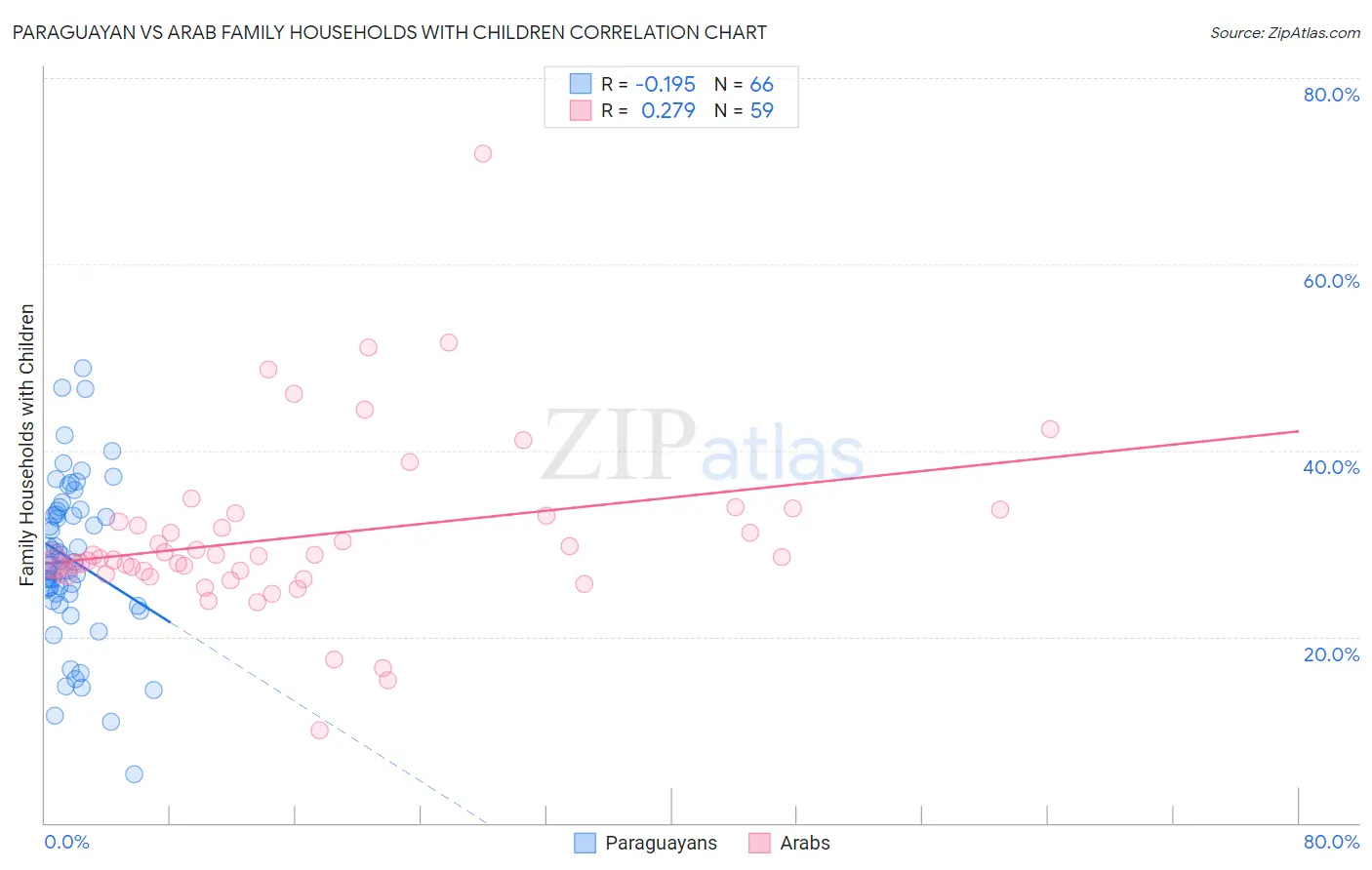Paraguayan vs Arab Family Households with Children
COMPARE
Paraguayan
Arab
Family Households with Children
Family Households with Children Comparison
Paraguayans
Arabs
27.1%
FAMILY HOUSEHOLDS WITH CHILDREN
9.4/ 100
METRIC RATING
222nd/ 347
METRIC RANK
28.0%
FAMILY HOUSEHOLDS WITH CHILDREN
97.0/ 100
METRIC RATING
113th/ 347
METRIC RANK
Paraguayan vs Arab Family Households with Children Correlation Chart
The statistical analysis conducted on geographies consisting of 95,067,312 people shows a poor negative correlation between the proportion of Paraguayans and percentage of family households with children in the United States with a correlation coefficient (R) of -0.195 and weighted average of 27.1%. Similarly, the statistical analysis conducted on geographies consisting of 486,135,019 people shows a weak positive correlation between the proportion of Arabs and percentage of family households with children in the United States with a correlation coefficient (R) of 0.279 and weighted average of 28.0%, a difference of 3.2%.

Family Households with Children Correlation Summary
| Measurement | Paraguayan | Arab |
| Minimum | 5.3% | 10.0% |
| Maximum | 48.8% | 71.9% |
| Range | 43.5% | 61.9% |
| Mean | 28.3% | 30.8% |
| Median | 27.9% | 28.6% |
| Interquartile 25% (IQ1) | 24.6% | 26.7% |
| Interquartile 75% (IQ3) | 33.5% | 33.0% |
| Interquartile Range (IQR) | 8.9% | 6.2% |
| Standard Deviation (Sample) | 8.6% | 9.4% |
| Standard Deviation (Population) | 8.5% | 9.4% |
Similar Demographics by Family Households with Children
Demographics Similar to Paraguayans by Family Households with Children
In terms of family households with children, the demographic groups most similar to Paraguayans are New Zealander (27.1%, a difference of 0.010%), Pima (27.1%, a difference of 0.010%), Austrian (27.1%, a difference of 0.030%), German (27.1%, a difference of 0.050%), and Immigrants from Japan (27.1%, a difference of 0.080%).
| Demographics | Rating | Rank | Family Households with Children |
| Northern Europeans | 12.8 /100 | #215 | Poor 27.2% |
| Cubans | 12.2 /100 | #216 | Poor 27.1% |
| U.S. Virgin Islanders | 12.1 /100 | #217 | Poor 27.1% |
| Greeks | 11.4 /100 | #218 | Poor 27.1% |
| Immigrants | Japan | 10.7 /100 | #219 | Poor 27.1% |
| Austrians | 9.9 /100 | #220 | Tragic 27.1% |
| New Zealanders | 9.6 /100 | #221 | Tragic 27.1% |
| Paraguayans | 9.4 /100 | #222 | Tragic 27.1% |
| Pima | 9.2 /100 | #223 | Tragic 27.1% |
| Germans | 8.7 /100 | #224 | Tragic 27.1% |
| Canadians | 7.5 /100 | #225 | Tragic 27.1% |
| Czechoslovakians | 6.6 /100 | #226 | Tragic 27.0% |
| Tsimshian | 6.6 /100 | #227 | Tragic 27.0% |
| Scottish | 6.5 /100 | #228 | Tragic 27.0% |
| Immigrants | Caribbean | 6.3 /100 | #229 | Tragic 27.0% |
Demographics Similar to Arabs by Family Households with Children
In terms of family households with children, the demographic groups most similar to Arabs are Immigrants from Middle Africa (28.0%, a difference of 0.010%), South American Indian (28.0%, a difference of 0.020%), Scandinavian (28.0%, a difference of 0.030%), Immigrants from Africa (28.0%, a difference of 0.030%), and Spaniard (28.0%, a difference of 0.10%).
| Demographics | Rating | Rank | Family Households with Children |
| Immigrants | South America | 98.0 /100 | #106 | Exceptional 28.0% |
| Immigrants | Uganda | 97.7 /100 | #107 | Exceptional 28.0% |
| Immigrants | Burma/Myanmar | 97.7 /100 | #108 | Exceptional 28.0% |
| Tohono O'odham | 97.6 /100 | #109 | Exceptional 28.0% |
| Spaniards | 97.4 /100 | #110 | Exceptional 28.0% |
| Scandinavians | 97.1 /100 | #111 | Exceptional 28.0% |
| Immigrants | Middle Africa | 97.0 /100 | #112 | Exceptional 28.0% |
| Arabs | 97.0 /100 | #113 | Exceptional 28.0% |
| South American Indians | 96.9 /100 | #114 | Exceptional 28.0% |
| Immigrants | Africa | 96.8 /100 | #115 | Exceptional 28.0% |
| Pakistanis | 96.0 /100 | #116 | Exceptional 27.9% |
| Immigrants | Malaysia | 95.9 /100 | #117 | Exceptional 27.9% |
| Central American Indians | 95.9 /100 | #118 | Exceptional 27.9% |
| Zimbabweans | 95.6 /100 | #119 | Exceptional 27.9% |
| Europeans | 95.4 /100 | #120 | Exceptional 27.9% |